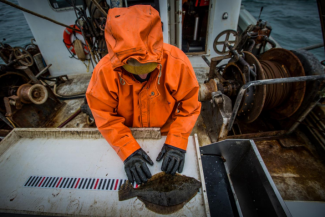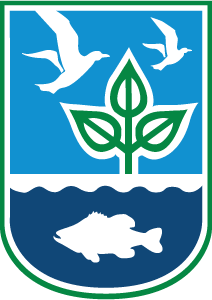RIMFI Research
The Rhode Island Marine Fisheries Institute contributes to both long-term monitoring efforts, as well as dedicated research projects. See the sections below to learn more about current and past RIMFI research.
Click the individual projects below to learn about ongoing research.
Principal Investigator: Anna Gerber-Williams (RIDEM DMF)
Collaborators: Christopher Roman (URI GSO), Conor McManus (RIDEM DMF), Dennis Erkan (RIDEM DMF)
Funding Source: U.S. Fish and Wildlife State Wildlife Grant
A collaborative research approach between the University of Rhode Island and the Rhode Island Department of Environmental Management’s Division of Marine Fisheries will assess the local bay scallop population structure within Southern Rhode Island’s salt ponds. The primary goal of this project is to gather and analyze bay scallop population data to improve the sustainability of the recreational fishery. Dive and snorkel surveys and autonomous kayak image gathering will be used to characterize relative abundance, size/age structure, and associated habitat of bay scallops. The image data collected from the autonomous kayak survey will be ground-truthed with the dive and snorkel results to develop new methodologies for future bay scallop monitoring on a larger scale. Data produced from this project will be used to better inform management processes for the state of Rhode Island.
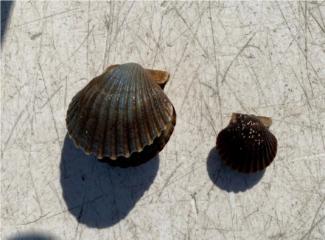
Principal Investigators: Corinne Truesdale (RI DEM), Jeremy Collie (URI GSO)
Funding Source: Atlantic States Marine Fisheries Commission (ASMFC)
This project will use a collaborative approach to develop harvest control rules for the data-limited southern New England Jonah crab fishery. For most of the 20th century, Jonah crab was considered a bycatch species of the American lobster fishery. Over the past twenty years, however, there has been a substantial increase in Jonah crab landings as lobster fishers have pivoted to target this species. Jonah crab remains a data-limited species for which a stock assessment has not yet been conducted; thus, the effects of the growing fishery on population status are not well understood. In this project, collaborative workshops will be held to solicit Jonah crab fishery stakeholders’ perspectives on potential harvest control rules for the fishery and suggestions for metrics to use in assessing the Jonah crab stock. A population simulation tool will be developed to model southern New England Jonah crab population dynamics and to test the proposed harvest control rules’ effects on the stock. The participatory harvest control rule development process is intended to facilitate the identification of control rules that are workable across a diverse group of stakeholders and represent optimal management strategies for the fishery.
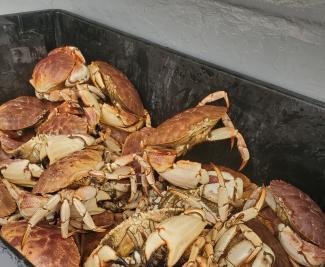
Long-term monitoring is paramount for understanding changes in ecosystems and individual species’ populations through time. As such, the RIMFI strongly supports collaborative efforts to construct and maintain long-term monitoring of our marine ecosystem. Below are examples of RIMFI long-term monitoring programs.
Begun by Charles Fish in 1959, the University of Rhode Island Graduate School of Oceanography (URI GSO) Fish Trawl Survey was established to quantify the seasonal patterns of migratory fish and invertebrates for Narragansett Bay. This bottom-trawl survey has been maintained over time with the leadership of URI GSO’s faculty, with the continued data collection proven invaluable to assessing both seasonal and long-term changes to both the Narragansett Bay and northwest Atlantic ecosystems. With almost 60 years of weekly data collected from a mid-Bay (Fox Island) and an open ocean (Whale Rock) site, the dataset serves as one of the longest continuous records for fish and invertebrate abundances in the world. The Fish Trawl Survey is funded by the University of Rhode Island and the Rhode Island Department of Environmental Management’s Division of Marine Fisheries, both understanding how important it is to maintain the time series data. The Survey has long served as both an educational opportunity for graduate students and the basis for many student’s thesis and dissertation research. Further, government scientists have leaned on this dataset to infer changes in fish populations, and for use as direct input into stock assessment models for many marine species. To learn more about the survey, visit the survey’s home page: https://web.uri.edu/fishtrawl/.
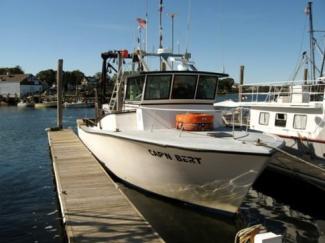
In 2020, scientists at the University of Rhode Island (URI) and the Rhode Island Department of Environmental Management (DEM) launched a long-term monitoring project to study the role of Narragansett Bay kelp ecosystems in shaping ecological dynamics. Specifically, there are two motivating questions for this program: (1) To what extent do kelps impact fish and invertebrate productivity and community assemblages? (2) How will a rapidly changing environment (e.g., water temperatures and nutrients) affect kelps and their associated communities through time? These data will help inform habitat conservation needs and assist in an ecosystem-based fisheries management approach. The program uses standardized underwater visual census methods to be able to compare kelp ecosystems in Rhode Island to other ecosystem engineers being monitored by DEM and partners, including oyster reefs, eelgrass beds, salt marshes, and artificial reefs. Annual sampling via SCUBA is conducted at sites across Narragansett Bay to collect data on benthic composition, fish and invertebrate abundance, kelp density, structural complexity, and kelp blade morphometrics. Temperature loggers are also placed at sites and water samples are taken for nutrient analysis. The program serves as an educational opportunity for students at URI as well as scientists at DEM to engage in field research and will eventually be the basis for many student projects. To learn more about the survey, visit ahumphrieslab.com/kelp-ecosystem-dynamics.

Click the individual project links below to learn about completed research projects.
Principal Investigator: Coleen Suckling (FAVS, URI)
Collaborators: Anabela Maia (BIO, RIC), Conor McManus (RI DEM), Austin Humphries (FAVS, URI), Terry Bradley (FAVS, URI), Andrew J. Davies (BIO, URI)
Funding Source: RI STAC
Predictive models are a widely used tool to determine how marine communities will respond to changing temperatures which can influence decision making processes. However, these models are often parameterized using historical and literature data. Therefore, they often don’t take into consideration species-specific responses, physiology or the rates of climate change expected in the coming decades which are expected to exceed changes recorded in historical records. This project assesses the responses of three key model fish species which feed on planktonic communities (e.g. Atlantic silversides, Alewife, Menhaden) used within NSF EPSCoR’s RI C-AIM program to near future climate change by making stronger links with physiology to explain any alterations in responses commonly incorporated in modeling efforts (e.g. food consumption, growth, survival). Furthermore we will identify whether classic modelling approaches of clustering species responses together within functional groups overgeneralizes response variables and how this might impact predictive modelling efforts.
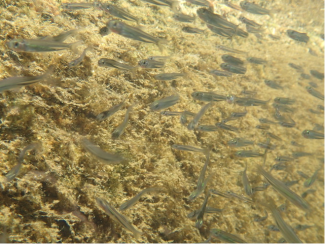
Principal Investigator: Coleen Suckling (FAVS, URI)
Collaborators: Ed Baker (GSO, URI), Kathleen Catreau (FAVS, URI), Marta Gomez-Chiarri (FAVS, URI), Austin Humphries (FAVS, URI), Conor McManus (RI DEM).
Funding Source: RI C-AIM (EPSCoR)
Rapid changes in the climate threaten the future of marine coastal ecosystems. Warming temperatures and ocean acidification are amongst the major seawater changes that strongly influence marine communities. However, much of our understanding of how communities respond to change have been extrapolated from predictive models built primarily upon published data. Such an approach is risky, particularly when attempting to enhance decision making at the regional, community or species level. Models are only as good as the quality of the data that is being entered and when parameterizing models, there is a need to ensure that the best available data, which considers key species, particularly those from the regional species pool.
The goal of this project is to address these gaps by contributing new information that will enhance models developed to predict changes in New England’s coastal ecosystem. There is strong evidence to show that coastal mollusks (e.g. mussels) are vulnerable to the effects of climate change (ocean acidification and warming) but there is little consideration on how key molluscan predator physiology and feeding behavior will be impacted, since this will influence molluscan community structures. The few studies which do take this focus fail to address the metabolic status of the predator and whether food intake can satisfy their energetic requirements. In this context, it is not known whether predators select larger and higher value prey with greater return for effort or opt for smaller and lower value prey with less return for effort. Any changes in predatory metabolic status under a future climate will strongly influence their predatory pressure on molluscan coastal communities and how they are structured. This information is urgently required for decision-making processes associated with their management.
In this project we are currently addressing this knowledge gap by focusing on key starfish and crab species that are known to predate on ecologically and economically relevant East-Atlantic coastal bivalve mollusks (mussels) using the University of Rhode Island’s Bay Campus aquarium facilities.
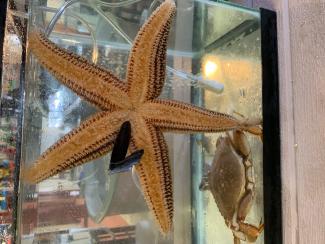
Principal Investigator: Natalie Ameral (URI CELS/RI DEM), Jonathan Puritz (URI CELS)
Collaborators: Conor Mcmanus (RI DEM), Scott Olszewski (RI DEM), Kim Gaffett (RINHS/TNC), Diandra Verbeyst (TNC)
Funding Source: U.S. Fish and Wildlife State Wildlife Grant
Through collaboration between the Rhode Island Department of Environmental Management’s Division of Marine Fisheries and the University of Rhode Island, this project team aims to assess population structure of horseshoe crabs in Rhode Island and nearby waters using a multidisciplinary approach. The goal of this research is to ascertain whether there are discrete, segregated populations of horseshoe crabs in Rhode Island waters, how different they are from other Southern New England states, and whether there is mixing between spawning contingents. Crabs will be assessed at sites with their associated environmental data collected, have genetic samples taken from the crabs, and released with a tag. Molecular analyses will confirm whether physically segregated crabs are genetically different or unique to the water bodies they inhabit. Phenotypic and environmental data collected for crabs genetically sampled will provide inference on how prospective genetic differences relate to the crabs’ niches. The tagging portion of this project will demonstrate on a more tangible and individualized scale crab mixing rates between water bodies and their degree of site fidelity. The data produced by this project can be used by the state of Rhode Island and the Atlantic States Marine Fisheries Commission to make informed decisions on management actions for horseshoe crabs both in state and on a coastwide scale toward preserving the stock.
Principal Investigator: David Bidwell (URI Marine Affairs)
Collaborators: Tiffany Smythe (CRC), Tracey Dalton (URI Marine Affairs), Julia Livermore (RI DEM), David Beutel (CRMC)
Funding Source: Rhode Island Sea Grant
The 30-MW, 5-turbine Block Island Wind Farm (BIWF) has received a great deal of attention as the first operational offshore wind energy project in the U.S. and is expected by many to kick start a broader development of the technology off the Atlantic coast. This study will investigate recreational fishing around the BIWF with the goal of improving understanding of the local, statewide, and regional socio-economic impacts of the BIWF on the angling activities of both Rhode Islanders and tourists. It will achieve this through an iterative, mixed-methods research approach, involving qualitative interviews of key stakeholders, representative quantitative surveys of saltwater anglers, and a legal analysis.
The overriding research question guiding this study is: How is the BIWF affecting the experience of recreational saltwater angling in Rhode Island? The primary goal of this project is to provide information that is useful for resource managers, the recreational fishing community, and other stakeholders in management of the BIWF and planning for future offshore wind energy developments.
Principal Investigator: Jeremy Collie (URI GSO)
Collaborators: Corinne Truesdale (URI GSO), Conor McManus (RI DEM)
Funding Source: U.S. Fish and Wildlife State Wildlife Grant
The Jonah crab (Cancer borealis) is an increasingly important marine resource in New England commercial trap fisheries, where landings of Jonah crab have risen nearly eight-fold since the 1990s. Rhode Island-based vessels have consistently accounted for about 25% of the United States commercial harvest, with Massachusetts comprising most of the remainder. Despite its rapid growth, the fishery was unregulated until 2015, when the first Fishery Management Plan (FMP) for Jonah crab was published by the Atlantic States Marine Fisheries Commission (ASMFC). The FMP highlights specific data needs necessary to inform sustainable management of the fishery. Data concerning the growth, distribution, and fishery characteristics of Jonah crab are considered priorities, and are important for understanding the impacts of increasing harvest levels on the resource biomass.
This project will (1) describe the size composition, sex ratios, and seasonal harvest trends of Jonah crabs in the commercial fishery through sea sampling on vessels operating in the Rhode Island Sound, and (2) characterize the growth and molting seasonality of adult Jonah crabs in Rhode Island waters by monitoring Jonah crabs in laboratories at DEM and the Graduate School of Oceanography. Results of this research will be provided to the ASMFC Jonah Crab Technical Committee for incorporation into the FMP and range-wide stock assessment.
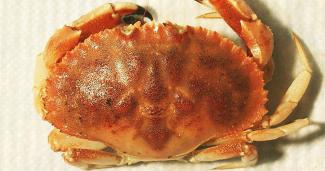
Principal Investigator: Tracey Dalton (URI CELS)
Collaborators: Corinne Truesdale (URI CELS), Conor McManus (RI DEM), Jason McNamee (RI DEM)
Funding Source: U.S. Fish and Wildlife State Wildlife Grant
The Jonah crab fishery in Southern New England has experienced rapid growth since the 1990s. In response to growing concerns about the sustainability of the resource, the first Fishery Management Plan for the species was published in 2015 by the Atlantic States Marine Fisheries Commission. This document lists many data types that are necessary for the creation of a range-wide stock assessment for Jonah crab, including biology and life history information, economic description of the fishery, and habitat preferences of the Jonah crab. Available data on the Jonah crab is sporadic, and many of the data types requested in the FMP are not available for the species across its range.
It is increasingly recognized that fishermen are an often-untapped source of knowledge on the fisheries in which they participate. In this project, researchers will interview Jonah crab fishermen throughout Southern New England to collect information on the life history and biology of the Jonah crab as well as social and economic aspects of its fishery. Interviews will be analyzed and compared with the literature to evaluate consistencies and to highlight potential areas for targeted future research. Results will be shared with Jonah crab scientists and fishery managers to inform the forthcoming Jonah crab stock assessment.
Principal Investigator: Marta Gomez-Chiarri (URI FAVS)
Collaborators: Tal Ben-Horin (URI FAVS), Baylor Fox-Kemper (Brown Univ), Susanne Menden-Deuer (URI GSO), Roxanne Smolowitz (Roger Williams Univ), and Eric Schneider (RIDEM DMF)
Funding Source: Rhode Island Research Alliance Grant Application, RIRA-CA-2019
Disease outbreaks have been pervasive across marine ecosystems and species, including corals, abalone, oysters, salmon, sea stars, and other. In many cases, the changing climate has worsened infections, but predicting how climate impacts disease is complex, especially on a local scale. It requires understanding how environmental changes more broadly impact ecological interactions that underlie disease processes. This collaborative research project brings together expertise in coastal marine ecology, aquatic pathology, and ocean modeling to integrate predictions from the Ocean State Ocean Model (OSOM) into ecological models quantifying how disease-causing parasites spread through coastal waters. Using a Bayesian modeling framework, we will integrate data from previous laboratory experiments into field surveys and dispersal predictions from the OSOM to describe the fate and transport of the oyster parasite Perkinsus marinus throughout Narragansett Bay. This naturally-occurring parasite severely impacts the value of the Rhode Island oyster aquaculture industry, the effectiveness of oyster restoration efforts, and the sustainability of wild oyster populations in the Ocean State. Our research addresses this management problem by:
1. Quantifying and predicting the abundance, transport, and fate of P. marinus around presumptive source sites in Narragansett Bay;
2. Refining estimates of P. marinus lifespan outside oyster hosts, including the contribution of grazing by zooplankton and benthic suspension-feeders to P. marinus removal;
3. Using the measured P. marinus distributions around source sites to evaluate predicted parasite distributions simulated from the OSOM, and comparing transport predictions to historical data on disease prevalence and severity in Narragansett Bay
We aim to catalyze future research directed at quantifying physical and ecological processes driving disease dynamics to improve our ability to predict disease outbreaks in a changing ocean.
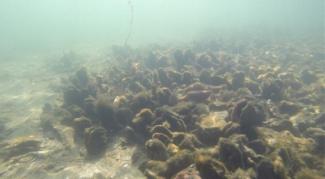
Principal Investigators: Annie Innes-Gold (URI CELS), Maggie Heinichen (URI GSO), and K. Gorospe (URI CELS)
Collaborators: Austin Humphries (URI CELS/GSO), Jeremy Collie (URI GSO), Conor McManus (RI DEM), Jason McNamee (RI DEM)
Funding Source: RI C-AIM (EPSCoR)
Ecological modelling is a powerful tool to explore relationships among species and ecosystem components. As the environmental conditions and external drivers change in the Bay, such as fluctuations in temperature, nutrients, and fishing pressure, there is a need to have an idea of how this will affect higher trophic species including those of commercial and recreational importance. This project looks to create an integrated ecosystem model linking the environmental, ecological, and human dimensions of Narragansett Bay. First, a qualitative model of these systems will examine the main components of each subsystem and explore the general relationships between them. The program Ecopath with Ecosim (EwE) translates this qualitative work into a quantitative model, exploring energy flow within the system and can be used to run temporally dynamic simulations.
The first phase of this project is to assemble the best data available for the model inputs, including biomass, production, consumption, and diet composition for species of ecological or commercial importance. The EwE model will be validated using historical fisheries catch and biomass data, and then used to predict how the ecosystem balance will change under different scenarios of environmental change. Finally, it will be coupled with further socio-cultural and environmental models to expand the scope of potential management applications. Our goal is to better understand and predict how environmental fluctuations and fisheries management policies will impact the Narragansett Bay foodweb.
Principal Investigator: Eric Schneider (RI DEM)
Collaborators: Jim Miller (URI OE) and Gopu Potty (URI OE)
Funding Source: U.S. Fish and Wildlife State Wildlife Grant
Atlantic sturgeon (Acipenser oxyrinchus oxyrhynchus) are one of the largest and longest-lived anadromous fish in North America. They migrate seasonally to spawning and foraging grounds throughout their range, which extends from Labrador, Canada to St. Johns River, Florida. In the spring of 2012 the species was listed under the Endangered Species Act (ESA) by NOAA Fisheries. Primary threats to recovery include mortality from bycatch and ship strikes, as well as habitat loss and degradation. Observations by fisherman and data collected by fishery observers provide certainty on their presence in Rhode Island state waters; however, we lack specific information on their spatiotemporal distribution. To effectively manage this listed species, we need to better understand when, where, and how Atlantic sturgeon are using areas and habitats within Rhode Island state waters.
Over the last ten years researchers along the East Coast have tagged more than 1,300 Atlantic sturgeons with acoustic transmitters. These acoustically tagged fish have been detected by receivers located in coastal waters along the East Coast, yielding critical information about the movement, migration, and use of habitat in state and coastal waters. Unfortunately, there is a lack of receivers between Long Island, NY and Cape Cod, MA. This project will use a collaborative research approach between the Rhode Island Department of Environmental Management, Division of Marine Fisheries (RI DEM) and the University of Rhode Island, Department of Ocean Engineering (URI OE) to design, implement, and maintain a series of acoustic receivers to detect the tagged Atlantic sturgeon in Rhode Island waters. Data collected by this project will be shared with the Atlantic Coast Telemetry (ACT) Network, adding to the coastwide dataset supported by more than 64 researchers focusing on 85 species. Specific to our objectives, this project will provide insight into the spatiotemporal distribution of Atlantic sturgeon in Rhode Island state waters.
Principal Investigator: Jeremy Collie (URI GSO)
Collaborators: Conor McManus (RI DEM), Rick Wahle (University of Maine)
Funding Source: National Sea Grant Program
The Southern New England (SNE) lobster stock is currently experiencing recruitment failure, with a population bottleneck occurring somewhere between the egg and juvenile stages. The objective of this project is to measure the abundance and spatial distribution of lobster larvae and post-settlement juveniles in Rhode Island waters to identify where in the life history the recruitment bottleneck occurs. The project components include lobster larvae sampling and temperature profile measurements, coupled with collector sampling that targets post-settlement and early benthic phase lobsters. Resulting data will be used to test whether lobster recruitment is limited more by pre- or post-settlement processes. The investigators will test whether a thermal refuge exists for juvenile lobsters at depths deeper than those that have been historically occupied. Field data will be interpreted in the broader context of circulation patterns and thermal habitat on the SNE continental shelf. A better understanding of the connectivity between egg production, pelagic larvae and benthic young-of-year, and juvenile abundances will provide insight into survival during this critical period of lobster life history. Understanding the processes regulating recruitment and the survival bottleneck is imperative for rebuilding the SNE lobster stock.
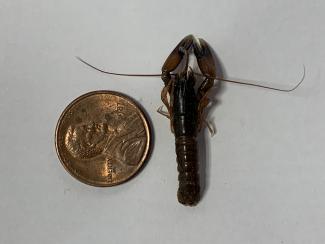
Principal Investigator: Jill Ashey (URI CELS), Hollie Putnam (URI CELS)
Collaborators: Conor McManus (RI DEM)
Funding Source: National Science Foundation
This collaboration aims to better understand the spatial and temporal population dynamics of Astrangia poculata, the northern star coral, in Rhode Island waters. Despite its status as the state coral of Rhode Island, little is known about A. poculata, its population dynamics, and its role in coastal ecosystems. To address these questions, ecological, physical, and physiological data will be integrated to assess A. poculata’s relative importance in coastal health and resilience, as well as the maintenance of fishery stocks. The unification of multi-faceted data types will provide an excellent opportunity to better understand A. poculata population structure and dynamics across different habitat types and begin to understand its role in coastal marine ecosystems. This project will summarize current knowledge on the species, where current knowledge gaps exist, and analyze existing data streams in support of determining the role of A. poculata in supporting fish and invertebrate habitat.
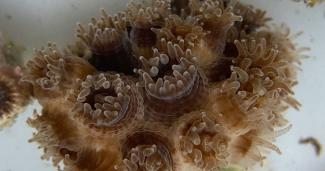
Principal Investigator: Julia Livermore (RI DEM)
Collaborators: Nichole Ares (RI DEM) and Tracey Dalton (URI/RI Sea Grant)
Funding Source: Atlantic Coastal Cooperative Statistics Program
For years, discussions on aggregate programs have garnered interest from the Rhode Island fishing community, especially for summer flounder, or fluke (Paralichthys dentatus), and black sea bass (Centropristis striata). With the variability of fish stocks, low quotas and subsequently low possession limits, and rising fuel and vessel maintenance costs, fisheries managers are being asked to provide more flexible fishing operation practices for the fishing industry. In 2019, the Rhode Island Department of Environmental Management Division of Marine Fisheries (DMF) implemented a pilot fluke-black sea bass aggregate program to collect data and assess the efficacy of an aggregate program for these species, where limited participants would be held to a weekly aggregate limit (daily limit, x days open) in lieu of a daily limit.
It was hypothesized that an aggregate program would allow fishermen more flexibility in fishing practices through the utilization of a weekly possession limit instead of a daily limit. Such a program could potentially decrease costs to the fishermen by decreasing days at sea (fuel and vessel maintenance costs decrease) while also increasing safety as fishermen could pick which days are the best in terms of weather. Aggregate programs could also decrease discards, and thus, discard mortality in some fisheries, especially at times when possession limits are low. This study aimed to evaluate these hypotheses by interviewing fishermen participating in the program with varying gear types and operations to collect business information (e.g. fuel, bait, ice, grocery, and labor costs, number of days fished). This data collection provided raw data that does not currently exist, and allowed for assessment of social components of the aggregate programs alongside analyses of the impacts to quota management.
In 2021 and 2022, 15 aggregate program participants were interviewed about their experience in and perception of the program. Based on the interviews conducted, participant perceptions of the pilot aggregate program were overwhelmingly positive, with some neutral comments (i.e., no changes or improvements relative to past fishing activity), and one negative comment (a concern about potential impacts to the summer flounder quota). All interviewees expressed a desire to stay in the program, depending on its future format, but most noted that they simply wanted to see the program continue in some form. A detailed summary of project findings is included in the final project report, available at: https://dem.ri.gov/sites/g/files/xkgbur861/files/2022-08/Pilot_Aggregate_Report.pdf
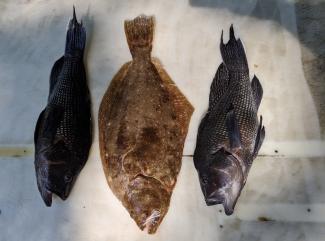
Principal Investigator: Jeremy Collie (URI GSO)
Collaborators: Joe Langan (URI GSO), Jason McNamee (RI DEM), Mark Gibson (RI DEM)
Funding Source: Rhode Island Sea Grant
Winter flounder (Pseudopleuronectes americanus) has historically supported large commercial and recreational fisheries as a prolific finfish in Rhode Island waters. However, its abundance has declined to an all-time low during the past three decades. As a cold-water, estuarine-dependent species, winter flounder has been shown to experience poor recruitment due to increased predation related to warming winters. Through this mechanism, climate change, in addition to past harvest pressure, is thought to be responsible for this population decline. While there are other stressors that could impact winter flounder survivability at different points in its life cycle, there has yet to be a comprehensive assessment of such factors or how they may interact with exploitation or environmental change.
This work seeks to collate multiple long-term data sets to identify the life-cycle stages at which winter flounder experience increased mortality and identify stressors, including harvest, climate change, predation, and pollution, that best explain this decreased survival through statistical modeling. Combining this knowledge with additional exploration of changing patterns of habitat use, a temperature-dependent life cycle model of winter flounder will be constructed to estimate the level of sustainable harvest both under current climate conditions and projected climate scenarios. Within this framework, the understanding of life stage-specific mortality and its drivers will be used to evaluate if adaptive fishery management methods can be used to enhance survival and ultimately determine the feasibility of recovering one of Narragansett Bay’s historically most important species.
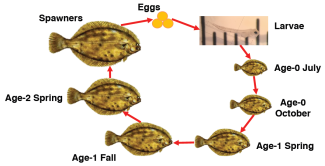
Principal Investigator: Thomas Sproul (URI CELS), Todd Guilfoos (URI CELS)
Collaborators: Julia Livermore (RI DEM)
Funding Source: Massachusetts Clean Energy Center, Bureau of Ocean Energy Management, RI DEM
This project was a collaboration between Dr. Tom Sproul and later Dr. Todd Guilfoos (Environmental & Natural Resource Economics at URI) and Julia Livermore (RI DEM). The overarching goal of this study was to generate improved maps of fishing effort and landings values at sea. A technical study was needed because established methods are known to contain substantial inaccuracies, and newer approaches have not been applied to species of interest in Southern New England’s offshore wind lease areas. The project helped to form a baseline that can be used to limit conflicts between wind development and commercial fishing and to assess changes in fishing practices after wind farm development. To achieve the project goals, the team merged data from the AIS (Automatic Identification System), VMS (Vessel Monitoring System), VTRs (Vessel Trip Reports), dealer reports, United States Coast Guard registry records, and the NOAA Observer Program. They then employed a novel approach of using fishing industry input to "engineer" features in a machine learning (random forest) model predicting the probability of fishing based on vessel activity at the Fishery Management Plan (FMP) level. The model results then enabled developing fishing activity maps by extrapolating to the full unlabeled dataset.

Principal Investigators: Katie Rodrigue (RI DEM), Austin Humphries (URI CELS/GSO)
Collaborators: Conor McManus (RI DEM), Scott Olszewski (RI DEM), Chris Parkins (RI DEM), Patrick Brown (RI DEM), Sean Fitzgerald (RI DEM)
Funding Source: U.S. Fish and Wildlife State Wildlife Grant
Through a collaboration between the Rhode Island Department of Environmental Management’s Division of Marine Fisheries and the University of Rhode Island, this project team aims to characterize the blue crab population in Narragansett Bay ahead of a potential emerging fishery. Although the blue crab is listed as a Rhode Island Species of Greatest Conservation Need in the 2015 Wildlife Action Plan, no assessment of the population in Rhode Island has yet been conducted. Research in Chesapeake Bay suggests that with milder winters brought on by climate change, their natural mortality may decrease, thus leading to increases in their populations. By implementing Rhode Island’s first ever winter blue crab dredge survey, this project will use catch data of dormant crabs to estimate their abundance and distribution in the bay. Data analysis may include, but is not limited to: creating size-based catch curves for determining mortality rate (and testing over-wintering survival hypotheses), using geospatial methods to determine how their abundance and distribution corresponds to environmental conditions, describing the sex ratio of the population to inform estimates of the spawning stock biomass, and describing the size composition to understand survey selectivity, seasonal growth or movement patterns, recruitment, and how current size limits relate to the population size structure.
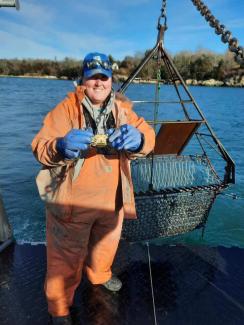
Principal Investigators: Jeremy Collie (GSO URI), Austin Humphries (GSO URI, FAVS), Conor McManus (RIDEM DMF), Candace Oviatt (GSO URI)
Funding Source: Rhode Island Sea Grant
This project aims to improve our understanding of the change in benthic communities of Narragansett Bay over time relative to nutrient reduction programs, changing water temperatures, and their synergistic effects. The present knowledge base is insufficient to measure and project the combined effects of nutrient reduction and temperature increases on the benthic communities of Narragansett Bay. Estimates of the biomass and production of all taxa are needed to assess the changes in benthic community structure and the resulting effects on the rest of the Narragansett Bay food web. The project has four main objective: to assess decadal changes in benthic community structure and biomass of Narragansett Bay in relation to temperature change, nutrient inputs, and water quality; to compare the abundance and species composition of benthic infauna and epifauna before and after the 50% decrease in nutrient input, which occurred from 2005 to 2013; to sample the entire benthic community (epifaunal and infaunal invertebrates and demersal fishes) along a north-south gradient with a combination of sampling gears, and; to estimate benthic production along this transect for input to food-web models
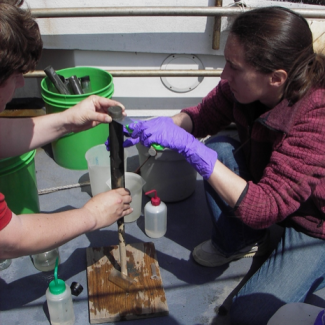
Principal Investigator: Lucie Maranda (URI GSO)
Co-Principal Investigators: David Ullman (URI GSO), Marta Gomez-Chiari (URI FAVS), Conor McManus (RI DEM)
Funding Source: Rhode Island Sea Grant
In the fall of 2016 and spring of 2017, Narragansett Bay (NB) and Rhode Island Sound (RIS) experienced a significant diatom bloom of Pseudo-nitzschia spp. Public health concerns have increased because of the known production of the neurotoxin domoic acid (DA) by many Pseudo-nitzschia species. The toxin can move through the food chain from plankton feeders to their predators. Further, humans eating DA-laden seafood experience gastrointestinal distress and, in acute and some chronic cases, seizures and memory loss, giving the syndrome the name of Amnesic Shellfish Poisoning, or ASP. As such, these blooms and DA presence has led RI DEM to periodically close local shellfish harvesting as a precautionary measure during the blooms, resulting in economic losses to the fisheries and aquaculture industries.
The main objective of this project is to determine the potential for intrusions of RIS water to carry harmful algae into NB. Through this work, we will (1) set a sentinel station in RIS to measure water properties and toxins in shellfish in waters prone to intrusions into NB, (2) establish the occurrence, abundance, and distribution of Pseudo-nitzschia spp. in relation to physical parameters within RIS and Lower NB, and (3) relate domoic acid uptake in blue mussels (Mytilus edulis) with Pseudo-nitzschia abundance and environmental variables to further our understanding of the bloom dynamics for improved management of shellfish resources.
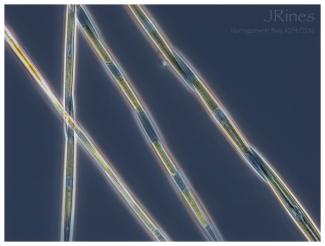
Principal Investigators: Candace Oviatt (GSO, URI), Roxanne Beinart (GSO, URI) and Conor McManus (RIDEM DMF)
Funding Source: Rhode Island Sea Grant
How shellfish in Narragansett Bay will respond to climate warming has not been fully investigated because local shellfish are impacted by several concurrent environmental changes. Shellfish themselves don’t only face warmer waters, but also face changes in food availability as the changes in water temperatures and nutrient inputs into the Bay may impact primary production. Additionally, shellfish populations in the Bay may be impacted by sediment quality and legacy pollutants that could limit shellfish reproduction.
To better understand how each of these dynamics will impact shellfish, researchers at URI GSO and RIDEM are running a set of mesocosm experiments analyzing the growth, survival, and reproductive potential of quahogs (Mercenaria mercenaria) and awning clams (Solemya velum) in three treatments: 1) ambient seawater; 2) seawater 2°C warmer than ambient; and 3) seawater 2°C colder than ambient. The winter spring diatom bloom in the Bay is synthesized with the addition of essential nutrients at the beginning of the experiment and primary productivity is monitored throughout the experiment. The shellfish are also raised in sediment gathered from the Providence River area and in the comparatively clean mid Bay region to assess the impacts of legacy contaminants on the reproduction of the shellfish. This aids in the assessment of food availability on shellfish life stages of growth and reproduction. Through these mesocosm experiments, the researchers gather information on life history rates under current environmental conditions in the Bay.

Principal Investigator: Conor McManus (RI DEM)
Collaborators: Jason McNamee (RI DEM), Rich Bell (TNC), Chris McGuire (TNC), Jeremy Collie (URI GSO), and Chris Brown (RICFA)
Funding Source: U.S. Fish and Wildlife State Wildlife Grant
This project will use a collaborative research approach to analyze fisheries-dependent data on windowpane flounder caught in the Southern New England. The primary purpose of this project will be to analyze trip and catch information from video data collected on commercial fishing trips to understand local populations of windowpane flounder. Video monitoring data from three Rhode Island fishermen’s trips will be analyzed to understand relative abundance, size structure, and habitat associations for windowpane flounder. This project will synthesize data from this video system, and compare data to other fisheries-dependent and independent datasets within Southern New England to evaluate similarities and differences between the data sources and methodologies. Data products from this work will be available to inform management processes for the Northeast Multispecies Fisheries Management Plan in the context of the windowpane flounder’s impact on the program and accountability area controls.
